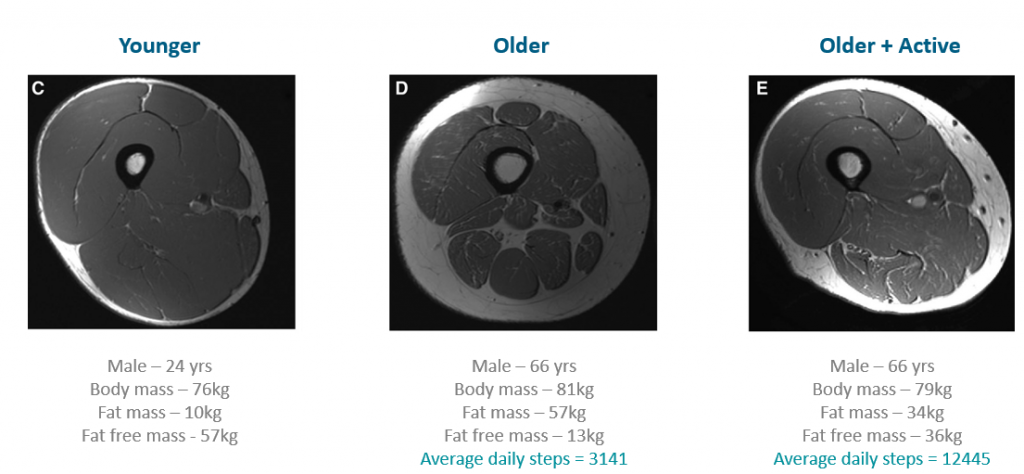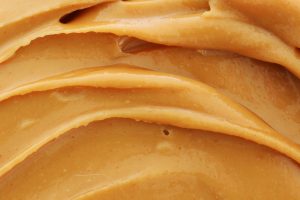Read Part 2 of this article: Active Ageing – How Can We Optimise Plant Proteins?
Although the average global life expectancy is now over 70 years, the focus for many people today is not “how old can I live to be?” Instead, the most important question has become “will I be able to do the things I want to do when I am older?” Retaining muscle mass is key for active ageing because it allows us to do the day-to-day activities we want to do, as well as protects us from falls and the associated injuries that can result.

Protein’s role in muscle health might be more than you think
Leucine and insulin are “switches” that activate protein synthesis
Most people think of protein, or the amino acids in protein, as the “building blocks” that our body uses to make muscle, but some amino acids have unique roles in metabolism. Scientists have shown that there is a metabolic “switch”, called mTOR, that signals new muscle production when it’s activated. Think of it as the body’s way to regulate creation or upkeep of muscle by promoting growth mainly when fuel or building blocks are plentiful (protein-rich food), or when the body senses an external need for muscle growth or repair (exercise).
Leucine, an essential amino acid that we must get through our diet, plays an important role in turning this “switch” on. When present alongside insulin, which is a hormone that has a key role in telling the body that fuel is plentiful, leucine will activate the mTOR “switch” to allow for creation of new and upkeep of existing muscle protein (Columbus et al., 2015; Ham et al., 2014).
Our ability to activate muscle growth and repair decreases as we age, leading to a loss in strength and ability to perform physical activities
It has been shown that as we age, our ability to stimulate this mTOR complex is reduced which, in turn, reduces our ability to repair and replace protein in muscle tissue. This is thought to be because of a concept called anabolic resistance, which refers to a decreased sensitivity to insulin throughout the body as we get older (Yoon, 2017).
This helps explain why muscle mass gradually starts to decrease as we get older. After the age of 50, approximately 1% of muscle mass is lost annually.
We lose up to 40% of the cross-sectional area of our muscles between the ages of 20 and 60 years; this continues each year thereafter as a result of developing resistance to protein synthesis stimulation (Vandervoot 2002).

Cross-sections of muscle showing the impact physical inactivity can have on muscle mass during ageing. Taken from the webinar Active Ageing: Distinct Nutrition, Distinct Innovation? McLeod M., Breen L., Hamilton D.L., Philp A. (2016) Live strong and prosper: the importance of skeletal muscle strength for healthy ageing. Biogerontology 17(3):497-510.
A loss of between 30-50% of our total muscle mass by the age of 80 often translates into a severely reduced ability to perform day-to-day activities like climbing stairs, standing, or walking.
Increased protein intake can counteract age-related muscle loss
Increased protein intake may be able to counteract this decreased insulin sensitivity that comes with ageing, which is called anabolic resistance. For young children and adults (< 30 years), the mTOR complex is mostly stimulated by insulin, meaning less leucine (and thus protein) is required to be consumed in each meal (approx. 1g leucine per meal). As individuals age, the sensitivity of the mTOR complex to insulin reduces and this means that more leucine (2.5g per meal) is required to sufficiently stimulate muscle protein synthesis. This means older adults need to consume more protein than younger adults and children to maintain muscle mass (Yoon, 2017). According to a study by Moore et al. in 2014, older adults need 68% more protein to maximize protein synthesis (i.e. activate mTOR).

The dietary recommendation for protein intake from the World Health Organisation is 0.8g per kilogram of body weight (BW) per day, which is equivalent to around 64g per day for the average male and 55g per day for the average female. This amount is thought to meet the requirements of healthy adults, but there is scientific debate about whether this recommendation should be greater in older adults.
In a study by Campbell et al. (2001), 10 healthy male individuals, aged between 55-70, were fed the Recommended Daily Allowance (RDA) for protein (0.8g/kg BW) over a 14 week period and the results showed that all subjects, bar one, displayed a loss of muscle in their mid-thigh muscle zones. It was concluded that the RDA may not be adequate for the metabolic and physiological need of virtually all ageing people.
How much more protein is needed?
As a result of studies like the one mentioned, groups such as the European Society for Clinical Nutrition and Metabolism (ESPEN) and the International PROT-AGE Study Group have proposed new recommended requirements for protein intake (Bauer et al., 2013; Deutz et al., 2014). They concluded that for healthy individuals over the age of 65 the recommended dietary protein intake should be increased to 1.0 – 1.2g protein/kg BW.
This would be an increase of 25-50% in the total amount of protein needed in a day for older adults, equivalent to daily intakes 80-93g per day for the average male and 69-83g per day for the average female.
Results from clinical studies have supported these higher recommendations with one such study by Houston et al. (2008) showing that ageing adults who had a daily protein intake of 1.1g protein/kg BW lost 40% less muscle over the course of three years when compared to those who were consuming the RDA value of 0.8g/kg BW.
Opportunity: increase both protein intake and frequency

Despite needing more protein at ages 50+, people generally tend to consume less protein as they age. For example, in the United States, men over 70 years old tend to eat around 20% less protein per day than males who are 19-50 years old.
To help people stay active and independent as they age there’s an opportunity for the food and beverage industry to find ways to add protein into the diets of healthy agers. The amount of leucine needed to activate muscle growth and repair is thought to be equivalent to around 25-30g of high quality protein at a single eating occasion.
This means planning meals, or creating foods and beverages, with 25-30g of protein if they are meant to be consumed alone (e.g. meal replacement beverages), or 10-15g of protein if they are intended to be consumed at a meal or with other foods, is one way to improve muscle health. Choosing flavors and language that appeal specifically to active agers is also important.
Turn the “switch” on multiple times per day – opportunities for breakfast, snacks, and lunch
The more times the mTOR “switch” is activated per day via consuming protein, the more likely we are to grow or retain our muscle mass (Layman 2009). Many people consume low amounts of protein early in the day, such as at breakfast, mid-morning, and lunch, and consume a protein-heavy evening meal. This means that muscle growth is likely to be only activated once per day. By shifting protein toward the early parts of the day, we can activate this “switch” more times per day, leading to a greater retention of muscle through diet alone.
For some people, this doesn’t necessarily mean consuming more total protein in a day is required. Instead, it can be effective to redistribute protein intake to be more equal across the dayparts. Adding protein to breakfast foods and mid-morning snacks is a great way to promote more protein intake throughout the day. This could include fortifying common breakfast foods like oatmeal, cereals, yoghurts, etc., or creating new foods or beverages to consume alongside a meal.
Contributor:
-
References
Bauer, J., Biolo, G., Cederholm, T., Cesari, M., Cruz-Jentoft, A., Morley, J., Phillips, S., Sieber, C., Stehle, P., Teta, D., Visvanathan, R., Volpi, E., Boirie, Y., 2013. Evidence-based Recommendations for Optimal Dietary Protein Intake in Older People: A Position Paper From the PROT-AGE Study Group. J. Am. Med. Dir. Assoc. 14. https://doi.org/10.1016/j.jamda.2013.05.021
Campbell, W.W., Trappe, T.A., Wolfe, R.R., Evans, W.J., 2001. The recommended dietary allowance for protein may not be adequate for older people to maintain skeletal muscle. Journals Gerontol. – Ser. A Biol. Sci. Med. Sci. 56, M373–M380. https://doi.org/10.1093/gerona/56.6.M373
Columbus, D.A., Fiorotto, M.L., Davis, T.A., 2015. Leucine is a major regulator of muscle protein synthesis in neonates. Amino Acids 47, 259–270. https://doi.org/10.1007/s00726-014-1866-0
Deutz, N.E.P., Bauer, J.M., Barazzoni, R., Biolo, G., Boirie, Y., Bosy-Westphal, A., Cederholm, T., Cruz-Jentoft, A., Krznariç, Z., Nair, K.S., Tipton, K., Calder, P.C., 2014. Protein intake and exercise for optimal muscle function with aging: Recommendations from the ESPEN Expert Group. Clin. Nutr. 33, 929–936. https://doi.org/10.1016/j.clnu.2014.04.007
Ham, D.J., Caldow, M.K., Lynch, G.S., Koopman, R., 2014. Leucine as a treatment for muscle wasting: A critical review. Clin. Nutr. 33, 937–945. https://doi.org/10.1016/j.clnu.2014.09.016
Houston, D.K., Nicklas, B.J., Ding, J., Harris, T.B., Tylavsky, F.A., Newman, A.B., Jung, S.L., Sahyoun, N.R., Visser, M., Kritchevsky, S.B., 2008. Dietary protein intake is associated with lean mass change in older, community-dwelling adults: The Health, Aging, and Body Composition (Health ABC) study. Am. J. Clin. Nutr. 87, 150–155. https://doi.org/10.1093/ajcn/87.1.150
Layman DK. Dietary Guidelines should reflect new understandings about adult protein needs. Nutr Metab (Lond). 2009;6:12. Published 2009 Mar 13. doi:10.1186/1743-7075-6-12
Moore DR, Churchward-Venne TA, Witard O, Breen L, Burd NA, Tipton KD, Phillips SM. Protein ingestion to stimulate myofibrillar protein synthesis requires greater relative protein intakes in healthy older versus younger men. J Gerontol A Biol Sci Med Sci. 2015 Jan;70(1):57-62. doi: 10.1093/gerona/glu103. Epub 2014 Jul 23. PMID: 25056502.
Vandervoot, AA. Aging of the human neuromuscular system. Muscle Nerve. 2002;25(1):17-25.
Yoon, M.-S., 2017. mTOR as a Key Regulator in Maintaining Skeletal Muscle Mass. Front. Physiol. 8, 788. https://doi.org/10.3389/fphys.2017.00788.

 Ryan Hazlett (MSc) is an expert in the processing and application of nutritional ingredients, such as protein, into powders for use in foods and beverages. He is currently a RD&A technologist who joined Kerry Taste & Nutrition in 2020.
Ryan Hazlett (MSc) is an expert in the processing and application of nutritional ingredients, such as protein, into powders for use in foods and beverages. He is currently a RD&A technologist who joined Kerry Taste & Nutrition in 2020. 